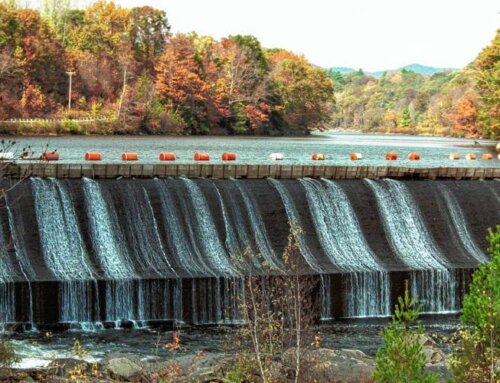Vermont. May, 2012. Experienced river users often refer to rivers, streams and lakes as being part of a watershed. We use the word because we are familiar with the notion that all surface water is connected to itself and some larger watery ecosystem. The classic definition of a watershed is: “The land area that drains surface and groundwater into the same larger body of water.”
To figure out your watershed just think about a raindrop that falls on the land. That raindrop may travel down a small rivulet to an unnamed stream to join a small brook that joins with other streams until you have a named river like the Mascoma or Wells Rivers that join the Connecticut River that flows into Long Island Sound. The main river travels some 375 to 410 miles to the Sound depending on the source of your information but a healthy river never goes from here to there in a straight line so attaching a specific length to the river is a human conceit. The river is as long as it wants to be.
We seldom identify with a huge watershed like the Long Island Sound watershed, mostly we think about our local rivers. Towns, organizations and regions are named for their local watersheds. Saxtons River Village, the West and White River valleys, the Ammonoosuc Community Trust and Connecticut Lakes Region are a few examples.
Watershed characteristics usually change as rivers move from the highlands to the plains. This is certainly true about Connecticut River if you think about its whole length. In the North Country the Connecticut is small, seemingly wild and intimate but south of our border it welcomes more power boaters as it passes through large cities. But interestingly enough, our Connecticut Lakes Region and the tidal marsh area at the mouth of the river are both wild places that welcome explorers for enjoyable fishing, boating, birding and wildlife viewing.
The Connecticut River experiences rising and falling water levels on a daily basis throughout most of its length. In the North Country it is the effects of the dams producing electricity. In the southern reaches the river is tidal. The name Connecticut River is an Anglicized version of the first peoples name for the river, ‘Quonehtacut’ that meant the Long Tidal River. The seasonal flow determines both the extent of the reach of saltwater up river and the tidal rise. At low flows the river is tidal for 60 miles from Long Island Sound all the way to Windsor Locks, CT. During spring freshet when the river can be discharging up to 29 billion gallons a day there is little noticeable tide away from the Sound. During dry times when the flow has lowered to 4.5 billion gallons a day the tide swing can be nearly 4 feet.
What is known as the “salt wedge”, the saltwater portion of the rising tide, extends all the way up river to Chester, CT, a distance of some 10 miles from the Sound. It is called a wedge because saltwater is heavier than freshwater and lifts the freshwater to the top. The saltwater mixes from the top down so at the leading edges of the tide the saltwater layer is the thinnest, hence the notion that the saltwater forms a wedge along the bottom of the river.
For those of us in the upper reaches of the river the most alluring place is the CT Lakes region where the headwater lakes start the river on its trip to the Sound. Starting in a bog know as the 4th CT Lake at the Canadian border the trickle that is the river joins with Indian Stream, Pauls Stream, the Mohawk River and by the time it reaches Colebrook, NH it is a real river. The country is wild, populated with moose and other critters that demand undisturbed habitat. The Lakes area is rich with water and the watershed there forms a tangle of backwater ponds and small lakes all draining into the river.
For many of the people in the lower reaches of the river the most alluring places are in the tidewaters area. In this reach of the river, because the river deposits so much silt and sand, no large port ever developed and the area was thought of as wasted land. Despite efforts to drain and “reclaim” the land the marshes have persisted and the wild species, especially birds, have succeeded in this undisturbed habitat. The tidewater area is recognized by the United Nations Ramsar Convention as “Wetlands of International Importance for birds.” The marsh areas are wild and just witnessing the bird life is worth the trip.
As different as The Great River is at its start compared to its finish, it is all the same watershed and it is all available for you to experience. For more information about how to get on the river throughout its length you can get the CRC Boating Guide at ctriver.org. You will also find links to other organizations that will help you experience the wonders of the Connecticut River, Source to Sea.
# # # #
David L. Deen, River Steward for the Connecticut River Watershed Council. CRC is celebrating 60 years as a protector of the Connecticut River.







